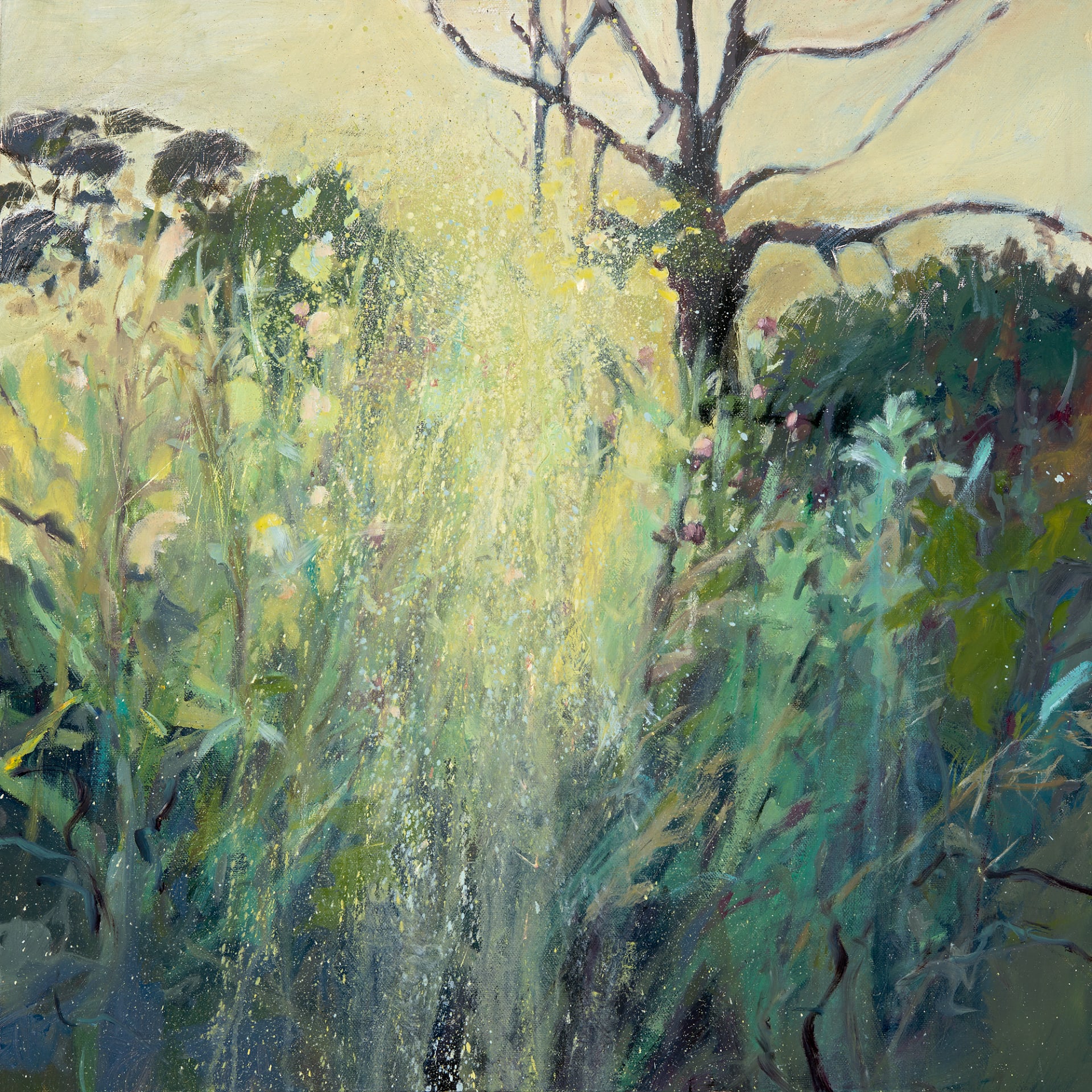Artist Lesley Wildman creates textile landscapes that teeter on the abstract by stretching yarn straight over a canvas. Together the lines create extraordinary seascapes and evocative countryside, both gentle and stark, through the seasons. Some show striking dark forests and reflections of awe-inspiring sunsets in icy lakes as long shadows stretch into darkness; others celebrate the softer beauty of lavender fields and fresh green grass or sculpt the occasional mist settled in the curves of The Cotswolds. As you pass a picture of the sea, light catches occasional lines of silver giving the illusion that the waves are moving towards you as sunlight dances lightly across their tips.
“I’m actually not keen on the sea,” she smiles. “When I stand on the beach in front of that great expanse of water, I see its voracious waves and inherent power, the sheer force of nature, which I try to convey. Although the ocean can have an apparent serenity, the surface is the outer skin of another world that’s deep, vast and intimidating – although, I worry about plastics rather than Poseidon’s mythical monsters!
I live in Chipping Norton, which is surrounded by incredible inspiring countryside. There’s an elemental strength to the natural environment and the ways it changes. I see it’s power in the shape of the earth, the colours of the golden wheat, the lush greens and the autumn leaves; and I love distilling that sublime beauty into basic linear elements.
I’ll often take a photo when I am out with the dog, which inspires me to create a new piece. I was blackberry picking recently and peering through the hedgerow, I could see the hills rolling away beyond: I’ve recreated this using dark thread around the edge of the canvas, which channels your vision as if between branches. The combination of light colours in the centre and the angles of the lines to the horizon, create the illusion of looking through and seeing into a place beyond.”
The horizon is crucial for the way we process signals from our eyes and for Lesley’s art. She describes how, growing up in the flat landscape of Bedfordshire, there was a very distinct and straight division between huge skies and the arable land that stretched to it below.
“The fields were farmed in straight lines too,” she adds. “Ploughed fields cut the landscape and the fenland countryside was very linear. I’m interested in the geometry of the way light reflects and how to portray that. Human biology and experience both lead us to expect to see certain things and our brains are very clever at seeing lines and shapes, textures and shadows using an in-built perspective and knowledge of the horizon. They turn electrical impulses from our eyes to creating the three-dimensional image we believe we can see, that we generate in our minds. I always had a fascination for trying to capture the 3D in two dimensions using angles and layers. People fill in the curves with their own ideas of the shapes they expect around them.”
Lesley Wildman is unquestionably a talented artist but, in another life, or a parallel universe she’d be a scientist. Her explorative and analytical mindset combines meticulous planning with the simplicity of layering lines to give surprising and liberating results.
“As a small child I loved the neatness of the formulaic approach to Painting by Numbers and my favourite toy was a science kit. I always imagined myself growing up to wear a white lab coat and have rows of test-tubes full of coloured liquids.
Training as a 3D designer, even when I was primarily working with glass, which naturally forms amazing soft organic shapes when it is molten, I created a circular sculpture from dozens of straight ‘lampwork’ glass rods. I’ll never stop being amazed at the way you can make circular shapes from straight lines when it would seem impossible at first glance.
I was a knitter too, in my spare time,” she explains. “I find it intriguing that you can use single line to produce garments and substantial objects, and for a number of years I co-owned the yarn shop Fibreworks in Chipping Norton. The new yarns that are available these days are phenomenal. Once upon a time, mothers would knit their children’s school jumpers as a financial necessity using a crunchy acrylic yarn. Now there’s everything from superfine merino wools, which are unbelievably soft, to a range of composites that include silk or metallic threads. ‘Cotton is sharp and crisp for example, whilst variegated types add an element of serendipity.
“I began working in this way with the wool,” Lesley explains, “when I was playfully wrapping a ball of wool around a canvas to see what it would look like when it was laid out, an odd line gave a unexpected depth. My eyes were starting to make out a sense of depth that wasn’t there. I experimented with different textures and colours and was fascinated that I could build simple scenes from stretched lengths.
Now I make complex landscapes which require careful planning, applying layers of colour giving the impression of a 3D scene just as a watercolour artist does, sometimes building up from the furthest away element of the landscape to the nearest. With a vast palette of colours it’s like painting but using only straight lines. I choose accent colours to pick out features. Touches of metallic thread add a fluidity to what you see in Nature, it’s moving lightly or glistening water and it’s that life and drama I am seeking to show in my art.”








